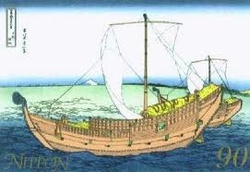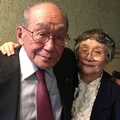Captain Jukichi’s Diary led me to the tale of Zensuke, another sea captain of the ship Eijyumaru, a vessel boastfully designated as “Sengokubune,” or One Thousand Koku boat (see previous post “Trip to Discover Kyoto History” regarding definition of “koku,” a unit of volume), measuring roughly 15 meters long, single-masted, capable of carrying 150 tons of rice and other cargo. However, the term 1000 Koku was loosely used. The English translation of Sengokubune was large junk-style ship. So chances were slim that this not-so-first-class Sengokubune could ride out a storm once out on the rough open ocean. Eijyumaru got shipwrecked in October 1841, off of Cape Inubozaki, Choshi during the voyage north to Sanriku Coast.
Zensuke and his 15 crew members drifted in the Pacific Ocean until they were rescued by a Spanish vessel. The ship landed at Cabo San Lucas in Baja California and the rescued crew eventually ended up in Mazatlan.
That reminds me of a chilling experience I had when I visited Mexico ten years ago. It was inside a Franciscan cathedral in Cuernavaca, about 200 miles (300km) inland from Acapulco, where I saw a narrative fresco mural of 27 martyrs crucified in Nagasaki, Japan. You have to adjust your sun-exposed eyes coming into the candle-lit chapel, so that the mural emerges slowly, sending a chill up your spine as you realize what it is about. It depicted Christians caught, bound, and heavily guarded traveling from Kyoto to Nagasaki to die on the scaffold. The mural chronicled their plight. Cuernavaca has many historical landmarks related to Conquistador Hernando Cortez (1485-1547) and Maximilian I (1832-1867).

Part of the mural work inside the Cathedral of Cuernavaca, Mexico (Photo by Alejandro Linares Garcia. Wikipedia.com)
Who painted the mural and when? Perhaps it was some years after the day of the mass crucifixion in 1579. Legend has it that it might have been a Filipino who sailed with the Spaniards. He most likely witnessed the cruel scenes with consternation and wanted to bequeath what he saw.
I was surprised to find the inscription “Emperador-Taycosama” perhaps referring to Hideyoshi (1526-1598) in the mural, the honorific use of tycoon, to indicate the awe and respect felt toward Hideyoshi.
I heard the wall had been covered over many times over the years where the mural remained hidden. Plastering over or replastering the wall signified the worshippers’ wish to cure local epidemics. The mural was discovered only when the church went through some renovations. It was a remarkable discovery. The muralist’s will to convey what happened back then finally reached me covering the span of 500 years in an instant as I looked at the wall. I was not so far removed from the person who traversed the Pacific Ocean and saw our ancestors as pagans.
Zensuke and four other crew members returned to Japan four years later in 1845 to Nagasaki back from Macao under Portugal. The other eight did not return.
The Nikkei Newspaper had a short article more than ten years ago of Mr. Yoshikazu Sano, TV producer, who explored what happened to the eight, who preferred to remain in Mexico, and televised what he found. In Mazatlan, he found Juan Machado and his descendents. Juan Machado was reported to have helped five of them in finding shelters and work, while they stayed there and waited for a boat to return to Asia. In Cabo, Mr. Sano wrote he found the tomb of Tomas Lichie, the name recorded in the Magistrate depositions. Sano was not able to track down descendents of the crew left behind, but he was happy to build a bridge and establish some goodwill between Japan and Mexico.
* This article was originally published on the author’s Riosloggers blog on March 5, 2011.
© 2011 Rio Imamura






